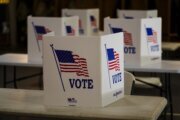WASHINGTON (AP) — The Supreme Court on Friday struck down a Trump-era ban on bump stocks, the rapid-fire gun accessories used in the deadliest mass shooting in modern U.S. history, in a ruling that threw firearms back into the nation’s political spotlight.
The high court’s conservative majority found that the Trump administration overstepped when it changed course from predecessors and banned bump stocks, which allow a rate of fire comparable to machine guns. The decision came after a gunman in Las Vegas attacked a country music festival with semiautomatic rifles equipped with the accessories.
The gunman fired more than 1,000 rounds into the crowd in 11 minutes, sending thousands of people fleeing in terror as hundreds were wounded and dozens killed.
The ruling thrust guns back into the center of the political conversation with an unusual twist as Democrats decried the reversal of a GOP administration’s action and many Republicans backed the ruling.
The 6-3 majority opinion written by Justice Clarence Thomas found the Justice Department was wrong to declare that bump stocks transformed semiautomatic rifles into illegal machine guns because, he wrote, each trigger depression in rapid succession still only releases one shot.
The ruling reinforced the limits of executive reach and two justices — conservative Samuel Alito and liberal Sonia Sotomayor — separately highlighted how action in Congress could potentially provide a more lasting policy, if there was political will to act in a bipartisan fashion.
Originally, imposing a ban through regulation rather than legislation during Donald Trump’s presidency took pressure off Republicans to act following the massacre and another mass shooting at a high school in Parkland, Florida. Prospects for passing gun restrictions in the current divided Congress are dim.
President Joe Biden, who supports gun restrictions, called on Congress to reinstate the ban imposed under his political foe. Trump’s campaign team meanwhile, expressed respect for the ruling before quickly pivoting to his endorsement by the National Rifle Association.
As Trump courts gun owners while running to retake the presidency, he has appeared to play down his own administration’s actions on bump stocks, telling NRA members in February that “nothing happened” on guns during his presidency despite “great pressure.” He told the group that if he is elected again, “No one will lay a finger on your firearms.”
The 2017 mass shooting in Las Vegas was carried out by a high-stakes gambler who killed himself, leaving his exact motive a mystery. A total of 60 people were killed in the shooting, including Christiana Duarte, whose family called Friday’s ruling tragic.
“The ruling is really just another way of inviting people to have another mass shooting,” said Danette Meyers, a family friend and spokesperson. “It’s unfortunate that they have to relive this again. They’re really unhappy.”
Republican Nevada Gov. Joe Lombardo, the former county sheriff in Las Vegas who has refused to sign multiple gun control measures the Democrat-controlled Legislature has sent to his desk, said in a statement Friday, “While I have always been a supporter of the Second Amendment, I have been a vocal opponent of bump stocks since my time in law enforcement, and I’m disappointed by the Supreme Court’s decision today.”
The opinion comes after the same Supreme Court conservative supermajority handed down a landmark decision expanding gun rights in 2022. The high court is also expected to rule in another gun case in the coming weeks, challenging a federal law intended to keep guns away from people under domestic violence restraining orders.
The arguments in the bump stock case, though, were less about Second Amendment rights and more about whether the Bureau of Alcohol, Tobacco, Firearms and Explosives, a Justice Department agency, had overstepped its authority.
Bump stocks are accessories that replace a rifle’s stock, the part that rests against the shoulder. Invented in the 2000s, they harness the gun’s recoil energy so that the trigger bumps against the shooter’s stationary finger, allowing the gun to fire at a similar speed as an automatic weapon.
The Supreme Court majority found that the 1934 law against machine guns defined them as weapons that could automatically fire more than one shot by a single function of the trigger. Bump stocks don’t fit that definition because “the trigger must still be released and reengaged to fire each additional shot,” Thomas wrote. He also pointed to over a decade of ATF’s findings that claimed bump stocks weren’t automatic weapons.
The plaintiff, Texas gun shop owner and military veteran Michael Cargill, applauded the ruling in a video posted online, predicting the case would have ripple effects by hampering other ATF gun restrictions. “I’m glad I stood up and fought,” he said.
In a dissent joined by her liberal colleagues, Justice Sotomayor said that bump stocks fit under the ordinary meaning of the law: “When I see a bird that walks like a duck, swims like a duck, and quacks like a duck, I call that bird a duck,” she wrote. The ruling, she said, could hamstring the ATF and have “deadly consequences.”
ATF Director Steve Dettelbach echoed the sentiment, saying that bump stocks “pose an unacceptable level of risk to public safety.”
The high court took up the case after a split among lower courts. Under Republican President George W. Bush and Democrat Barack Obama, the ATF decided that bump stocks didn’t transform semiautomatic weapons into machine guns. The agency reversed those decisions at Trump’s urging. That was after the Las Vegas massacre and the Parkland, Florida, shooting that left 17 dead.
Sixteen states and the District of Columbia have their own bans on bump stocks that aren’t expected to be affected by the ruling, though four state bans may no longer cover bump stocks in the wake of the ruling, according to the gun-control group Everytown.
Cargill was represented by the New Civil Liberties Alliance, a group funded by conservative donors like the Koch network. His attorneys acknowledged that bump stocks allow for rapid fire but argued that they are different because the shooter has to put in more effort to keep the gun firing.
The Biden administration had argued that effort was minimal, and said the ATF came to the right conclusion on bump stocks after doing a more in-depth examination spurred by the Las Vegas shooting.
There were about 520,000 bump stocks in circulation when the ban went into effect in 2019, requiring people to either surrender or destroy them at a combined estimated loss of $100 million, the plaintiffs said in court documents.
___
Associated Press writers Mark Sherman and Lisa Mascaro in Washington, Jill Colvin in New York, Mike Catalini in Trenton, New Jersey, Jim Salter in St. Louis, Scott Sonner in Reno, Nevada, and Jim Vertuno in Austin, Texas, contributed to this report.
___
This story has been updated to correct a reference assault rifle rather than semiautomatic rifle.
___
Follow the AP’s coverage of the U.S. Supreme Court at https://apnews.com/hub/us-supreme-court.
Copyright © 2024 The Associated Press. All rights reserved. This material may not be published, broadcast, written or redistributed.







